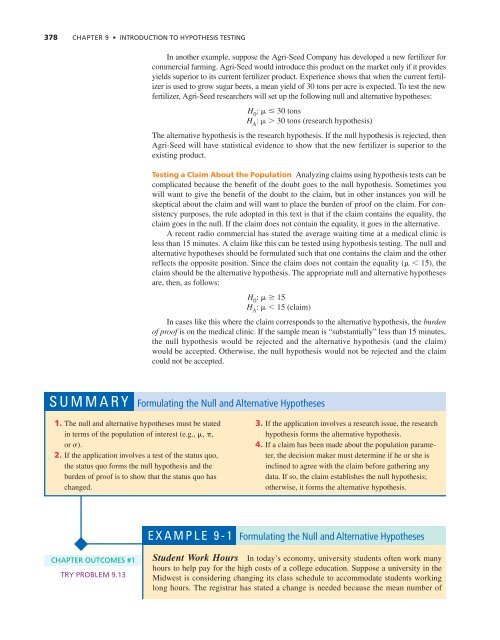Chapter 9: Introduction to Hypothesis Testing
Chapter 9: Introduction to Hypothesis Testing
Chapter 9: Introduction to Hypothesis Testing
You also want an ePaper? Increase the reach of your titles
YUMPU automatically turns print PDFs into web optimized ePapers that Google loves.
378 CHAPTER 9 • INTRODUCTION TO HYPOTHESIS TESTING<br />
In another example, suppose the Agri-Seed Company has developed a new fertilizer for<br />
commercial farming. Agri-Seed would introduce this product on the market only if it provides<br />
yields superior <strong>to</strong> its current fertilizer product. Experience shows that when the current fertilizer<br />
is used <strong>to</strong> grow sugar beets, a mean yield of 30 <strong>to</strong>ns per acre is expected. To test the new<br />
fertilizer, Agri-Seed researchers will set up the following null and alternative hypotheses:<br />
H 0<br />
: 30 <strong>to</strong>ns<br />
H A<br />
: 30 <strong>to</strong>ns (research hypothesis)<br />
The alternative hypothesis is the research hypothesis. If the null hypothesis is rejected, then<br />
Agri-Seed will have statistical evidence <strong>to</strong> show that the new fertilizer is superior <strong>to</strong> the<br />
existing product.<br />
<strong>Testing</strong> a Claim About the Population Analyzing claims using hypothesis tests can be<br />
complicated because the benefit of the doubt goes <strong>to</strong> the null hypothesis. Sometimes you<br />
will want <strong>to</strong> give the benefit of the doubt <strong>to</strong> the claim, but in other instances you will be<br />
skeptical about the claim and will want <strong>to</strong> place the burden of proof on the claim. For consistency<br />
purposes, the rule adopted in this text is that if the claim contains the equality, the<br />
claim goes in the null. If the claim does not contain the equality, it goes in the alternative.<br />
A recent radio commercial has stated the average waiting time at a medical clinic is<br />
less than 15 minutes. A claim like this can be tested using hypothesis testing. The null and<br />
alternative hypotheses should be formulated such that one contains the claim and the other<br />
reflects the opposite position. Since the claim does not contain the equality ( 15), the<br />
claim should be the alternative hypothesis. The appropriate null and alternative hypotheses<br />
are, then, as follows:<br />
H 0<br />
: 15<br />
H A<br />
: 15 (claim)<br />
In cases like this where the claim corresponds <strong>to</strong> the alternative hypothesis, the burden<br />
of proof is on the medical clinic. If the sample mean is “substantially” less than 15 minutes,<br />
the null hypothesis would be rejected and the alternative hypothesis (and the claim)<br />
would be accepted. Otherwise, the null hypothesis would not be rejected and the claim<br />
could not be accepted.<br />
SUMMARY Formulating the Null and Alternative Hypotheses<br />
1. The null and alternative hypotheses must be stated<br />
in terms of the population of interest (e.g., , ,<br />
or ).<br />
2. If the application involves a test of the status quo,<br />
the status quo forms the null hypothesis and the<br />
burden of proof is <strong>to</strong> show that the status quo has<br />
changed.<br />
3. If the application involves a research issue, the research<br />
hypothesis forms the alternative hypothesis.<br />
4. If a claim has been made about the population parameter,<br />
the decision maker must determine if he or she is<br />
inclined <strong>to</strong> agree with the claim before gathering any<br />
data. If so, the claim establishes the null hypothesis;<br />
otherwise, it forms the alternative hypothesis.<br />
EXAMPLE 9-1 Formulating the Null and Alternative Hypotheses<br />
CHAPTER OUTCOMES #1<br />
TRY PROBLEM 9.13<br />
Student Work Hours In <strong>to</strong>day’s economy, university students often work many<br />
hours <strong>to</strong> help pay for the high costs of a college education. Suppose a university in the<br />
Midwest is considering changing its class schedule <strong>to</strong> accommodate students working<br />
long hours. The registrar has stated a change is needed because the mean number of

















